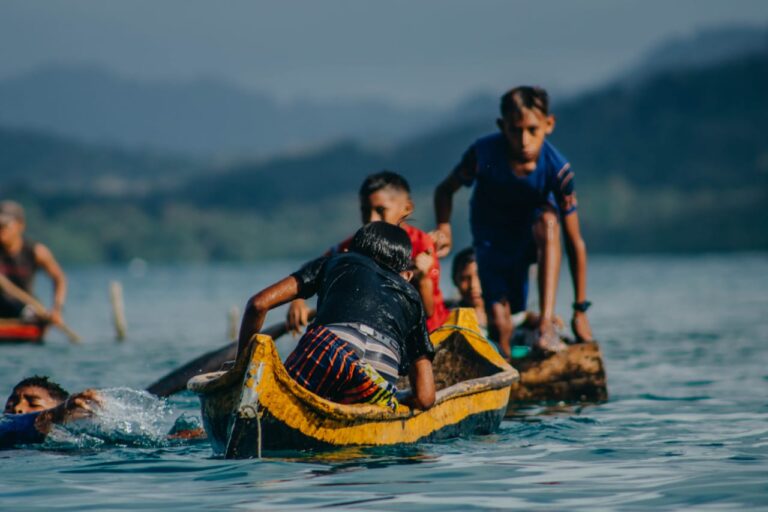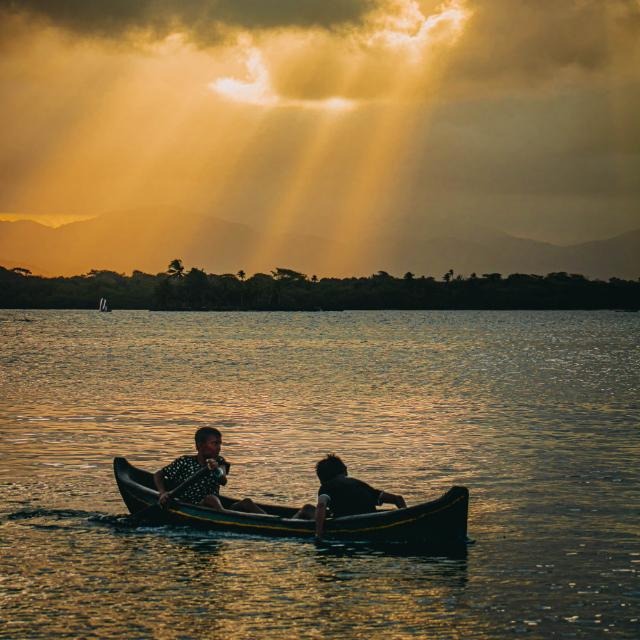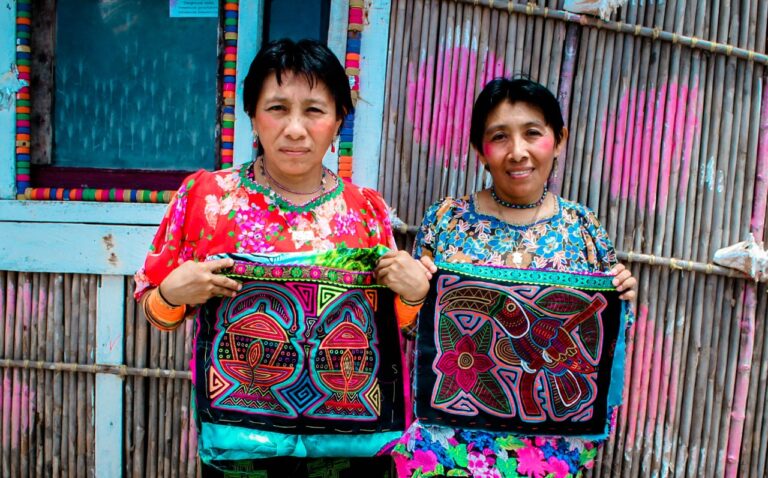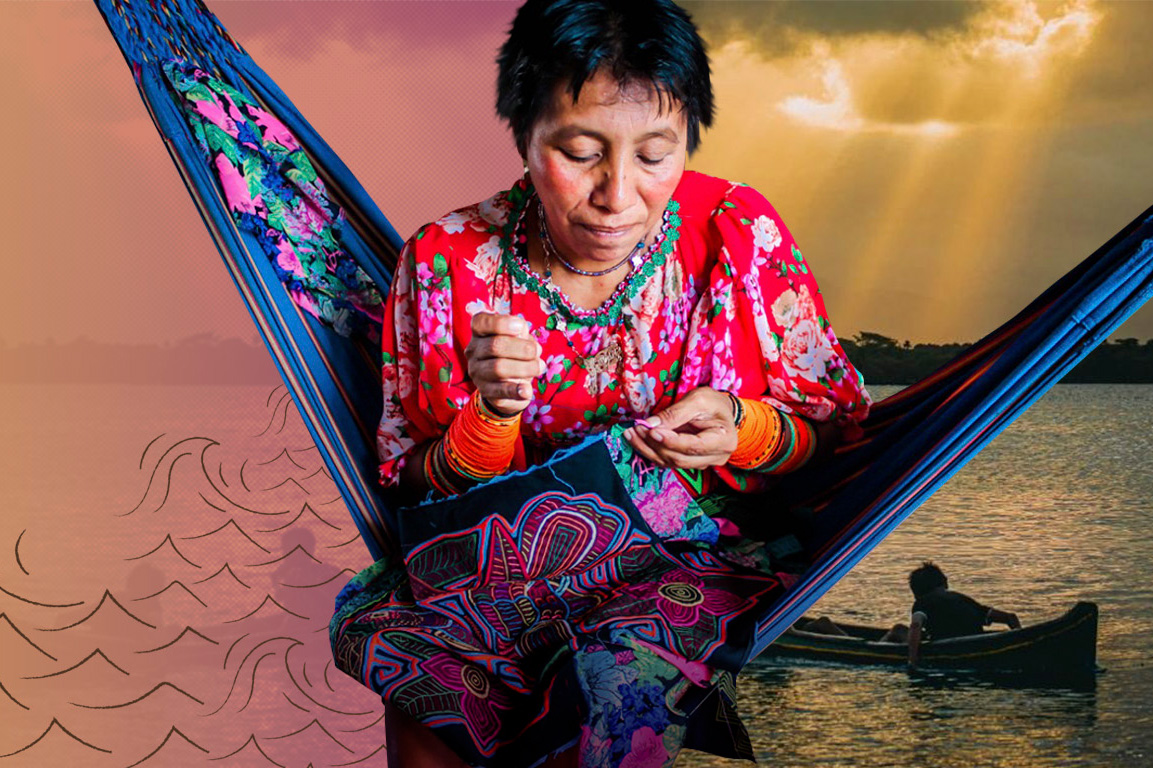The threats to grandmother Sea: a resistance view from the Gunadule people
Story by: Agenda Propia
Climate change puts the Gunayala region at risk. This region is inhabited by indigenous people of the Gunadule people, originally from Panama and Colombia. The rise in sea level threatens its survival. The indigenous people resist with stories and ancestral songs that have messages to live in community. One of them is the story of Muu Billi (of Grandmother Sea) that proposes a relationship of cosmo-existence of the Gunadules with the sea.
In the community of Digir (Tigre Island), in Gunayala, Panama, lives the grandmother Laura Arango, a Gunadule indigenous. She has witnessed how Grandma Sea’s tide has risen and year after year the water advances over the mainland on the islands, located in the Caribbean, many times generating great floods.
She accommodates herself in a hammock to explain these changes with the story and song of Muu Billi, which for us Gunadules means Grandmother Sea. My friend Norlando Meza, who is her grandson, and I are ready to listen to her; Not without first talking about the fact that in recent decades there has been a progressive rise in sea level that has affected the daily life and food security of our people.
– Grandmother Laura: When you were a child, the island of Digir was flooded like now?
– “There have always been seasons in which Grandma Sea renews herself and her waves grow to remove from her interior that which contaminates her. It is in this season that we know that it is dangerous to go fishing, because the waves are huge and strong. But from my childhood to this moment I have seen a profound change in various aspects. When I was a child, we ate fruits, bananas, corn, cocoa, so the peels did not hurt Grandma Sea.
When she cleaned herself, the waves rose, but it was a renewal that was good for everyone. When we went swimming, or fishing, even the river, it still looked beautiful and clean. But today it has changed because, when the waves rise, the islands fill with garbage and the water enters the island and the houses and we are flooded. We have seen how there is a change in the sea level ”.
During my visit to Digir, between January and February 2020, it was flooded. There, on the island, as of August 2021 the situation of sea level rise has not changed, it continues to rise.

Gunadul children sail and enjoy the waters of Grandmother Mar. Photo: Norlando Meza
Digir is one of the 38 islands of the 51 communities that make up the Gunayala Comarca, the remaining 13 are on the mainland, mostly in the coastal areas. The Comarca inherits the name from its mother tongue, which means “Earth Guna” or “Mountain Guna” and that the Government of Panama formally recognized since 1938 in accordance with a law issued in September of that year. Decades later, Gunayala is made official as a region, in accordance with Law 99 of December 1998, according to the official website of the Gunayala Traditional General Congress.
The 2010 census recorded that there were 33,109 inhabitants in the Gunayala region. Projections for 2020 estimated 47,341 people. However, the Gunayala Traditional General Congress establishes that the Gunadules number more than 80 thousand people. In Gunayala they live from subsistence farming, fishing, creating handicrafts and tourism.
Simion Brown, a Guna scholar, stated that at first our history and “tradition were rivers and sewers, and 250 years ago we began to reach the coasts.”
He relates that the knowledge of Grandmother Mar came from that time. “The saglas (spiritual guides and authorities of the communities) in their songs mention the living beings of the sea, the species that we still do not know, the eddies that are made by the winds and the waves that are only one so that the animals of the sea reproduce, during three months there are those strong winds, it is a natural season ”.
Simion says that the current changes in the climate and the over-exploitation that man makes of the natural resources and fish of the sea “can make us become extinct, therefore, the sea must be cared for.”
Reports submitted by the Panamanian State to the United Nations Framework Convention on Climate Change (UNFCCC) reveal that the islands are experiencing an “imminent and potentially worsening” threat. The rise in the sea could be estimated at approximately three centimeters in the last fifty years, according to information from the tide gauge located on the coast of Colón, a city located on the Caribbean coast of Panama, according to a report published by the United Nations in 2019 .
The change in sea level, as narrated by Grandmother Laura, adds to the problem of garbage that people throw into the ocean and that commercial and tourist boats that pass through this aquatic corridor also unload.
– “It is at this moment that we can see how the island fills with garbage, even unpopulated islands, when the waves remove the dirt from Grandma Sea’s body and concentrate on the shore,” says Grandma Laura.

The rays of the sun shine in the waters of the Caribbean Sea, while two indigenous people sail near the islands of the Gunayala region. Photo: Norlando Meza
Effects on the Gunadule people
The rise in sea level is one of the most worrying effects of the Gunadule people. It is generating a displacement due to climate change of the inhabitants of several islands, towards the continental area. One of these cases is already being experienced by the indigenous people of the Carti Sugdub island: they are the first group to have thought about relocation.
In 2010, the Gardi Sugdub island community created the “slum commission” to organize the process. As of 2014, some 300 families (approximately 1,500 people) from Gardi Sugdub had signed up to be transferred to the mainland, according to data from the 2014 report by the Displacement Solutions organization. But that transfer has not started.
Another case of climate damage occurred on January 11, 2020, when a strong wave reached the communities and islands of Niadup, Yandup, Maguebgandi, Malatupu, Naranjo Grande, Naranjo Chico and Maladup. The National Directorate for Project Coordination of the Ministry of Housing and Territorial Planning (MIVIOT) offered a response to the families affected by this phenomenon by rebuilding a part of the demolished huts, according to official information.
Also on Ustupo Island strong winds and storms have occurred. According to Doris J. Bill F., an indigenous Guna, the island has suffered from floods and destruction of houses. As the problem worsens in winter, many island residents return to the mainland, which, historically, was their home.
“To achieve social stability for indigenous communities, a land use plan is required. Few peoples have this protection. This legal instrument facilitates an adequate order and possession of land for each family, as a right of inheritance and accessibility to their territoriality ”, explains Doris.
The 2014 report by Displacement Solutions, an organization dedicated to finding solutions based on the rights of climate displaced people, emphasized the urgency of presenting action plans to tackle the problems in Gunayala. This study documents that the progressive displacement of inhabitants of the islands takes place without government support and with little dissemination at the national level. The report notes that “the lines of communication with government officials about the status of the various projects have not been reliable.”
Since 2014, Displacement Solutions noted that the government of Panama does not appear to have any official strategy to address the situation of the communities living on the islands in Gunayala.
However, in 2007 Panama approved the National Climate Change Policy (Executive Decree N.35), which contains objectives and lines of action to promote adaptation measures, protect the population and ensure sustainable development in the country. At the beginning of 2021, the National Directorate of Climate Change of the Ministry of Environment explained that the government is preparing the National Plan of Action for Climate, but does not specifically report on the situation of the Gunadules.
In addition, Panama presents other situations that are adding to the environmental crisis, which is “complicated by countless mining concessions, the alarming deforestation in protected areas and surrounding indigenous communities, the smuggling of energy generated from hydroelectric plants, the appropriation of of the rivers and the environmental damage produced only have the possibility of increasing with natural disasters ”, according to the Colectivo Voces Ecológica COVEC.
For their part, the affected communities have taken the initiative to work and propose solutions to this threat.
A youth initiative in the Gunayala region undertook actions such as talks and cultural activities to educate the population about what climate change represents, its effects and measures that contribute to counteracting its negative impacts, such as the Anyar initiative (“For our Territories”) , a project developed by the Youth Leadership Academy on Climate Change, and promoted by the Ministry of the Environment, with the support of the Konrad Adenauer Foundation and the United Nations Development Program (UNDP), according to local Panamanian media at the time.

Gunadule indigenous women show molas. In the fabrics they make in layers, the women capture all the knowledge including those of Grandma Mar. Photo taken from https://jocabedsolano.com/
Going back to the root
The legacy of grandparents and grandmothers lives on. The saglas sing to guide the communities with their own memories, their message is to go back to the roots, to the spirituality of the Gunadule people and in that way, also face the adversities of the climate.
Simion Brown reminds us that the Gunadule have great respect for Grandma Sea and that our culture is always in defense of harmony with nature.
– “The Sea is very important because it has a relationship with the living beings, especially with women who when they are in a state of development (pregnancy) cannot eat crabs, shells, large fish: can only do so when they reach the nine months. This phenomenon is called Muu, because Muu is like the uterus, that wisdom and everything is concatenated, everything has its order, it has its union and when we break that balance, harmony is broken”.
This imbalance that Simion talks about is related to the changes in climate, floods and high temperatures that our communities experience every day.
That is why one way to defend Grandma Sea is through knowledge.
– “This knowledge helps us to continue living with nature, especially where we are, on the islands, and it helps us to prevent, mitigate, and cope with climate change, which is something that is occurring at the level of nature ( …) When harmony is achieved, climate change can be overcome ”, reflects Simion.
Our identity is related to Grandmother Mar and Mother Earth, it is what gives us strength so that we are a people that continues to sing so as not to die and continues to sing to life. Even the women weave that feeling and worldview into the molas, they in fabrics of different colors create with layers the movement of the waves, the fish, the stars, the sun and the entire dimension of the ocean and the land.
Grandmother Laura, like so many Guna grandmothers, tells us about her memory in relation to Grandmother Mar (Muu Billi). The song he speaks of is a prayer to Baba and Nana (creators of the Gunadules), which reminds us of our relationship with Mother Earth and with every living being in Abya Yala (America). This ancient knowledge has been passed down from generation to generation and envelops the layers of wisdom of the Gunadule people.
Read the text of the song La abuela Mar Muu Billi (Link)
Note. The journalistic series A Look to the Territories ¡Resist to Heal!, was produced in a process of co-creation with indigenous and non-indigenous journalists and communicators from the Knitting Networks (Red Tejiendo Historias or Rede Tecendo Histórias), under the editorial coordination of the independent medium Agenda Propia.
